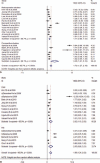Radiofrequency ablation for treatment of benign thyroid nodules: A PRISMA-compliant systematic review and meta-analysis of outcomes
- PMID: 27559968
- PMCID: PMC5400335
- DOI: 10.1097/MD.0000000000004659
Radiofrequency ablation for treatment of benign thyroid nodules: A PRISMA-compliant systematic review and meta-analysis of outcomes
Abstract
Background: Thyroid nodules (TNs) usually appearing in the general population have the potential possibility of malignant transformation and common problems of jugular oppression such as dyspnea and hoarseness. We performed this meta-analysis to evaluate the efficiency of radiofrequency ablation (RFA) for the treatment of benign TNs in accord with the Preferred Reporting Items for Systematic Reviews and Meta-Analyses statements.
Methods: Published literatures were retrieved from PubMed, Embase, Web of Science, and Scopus up to January 27, 2016. Pooled standard mean difference with 95% confidence interval was estimated by fixed- or random-effects model depending on heterogeneity, which was calculated using the Cochran Q, τ, and I statistics. The quality of the articles was evaluated by the Newcastle-Ottawa scale.
Results: Meta-analysis of data from 1090 patients with 1406 benign TNs in 20 articles showed that with the subgroup stratified by nodule volume, they were significantly decreased at 1, 3, 6, 12, and the last follow-up months, when comparing post-RFA with the initial nodule volume. In addition, the volume also notably declined by cold and hot nodules. By subgrouping into the largest diameter, symptom score, cosmetic score, thyrotropin, triiodothyronine, free thyroxine level, and vascularity, the pooled data indicated that there was a decrease in largest diameter, symptom score, cosmetic score, triiodothyronine level, and vascular scale, an unchanged free thyroxine, and an increased thyrotropin level after RFA. The publication bias for this particular study is presented in the following groups: nodule volume reduction at 6 months and last follow-up month after RFA and symptom score.
Conclusion: In summary, by pooling of these studies we recommended that RFA indeed has the advantages in improving outcomes and providing better prognosis for patients with benign TNs.
Conflict of interest statement
The authors have no conflicts of interest to disclose.
Figures



References
-
- Gharib H, Papini E, Paschke R, et al. American Association of Clinical Endocrinologists, Associazione Medici Endocrinologi, and European Thyroid Association medical guidelines for clinical practice for the diagnosis and management of thyroid nodules. J Endocrinol Invest 2010; 33:1–50. - PubMed
-
- Arora N, Scognamiglio T, Zhu B, et al. Do benign thyroid nodules have malignant potential? An evidence-based review. World J Surg 2008; 32:1237–1246. - PubMed
-
- Miccoli P, Minuto MN, Ugolini C, et al. Minimally invasive video-assisted thyroidectomy for benign thyroid disease: an evidence-based review. World J Surg 2008; 32:1333–1340. - PubMed
-
- Jeong WK, Baek JH, Rhim H, et al. Radiofrequency ablation of benign thyroid nodules: safety and imaging follow-up in 236 patients. Eur Radiol 2008; 18:1244–1250. - PubMed
Publication types
MeSH terms
LinkOut - more resources
Full Text Sources
Other Literature Sources
Medical
Molecular Biology Databases

